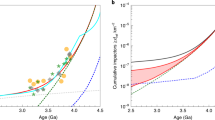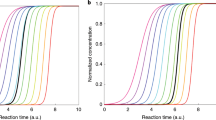Abstract
Much of the mass of most meteoroids entering the Earth's atmosphere is consumed in the process of ablation. Larger meteoroids (> 10 cm), which in some cases reach the ground as meteorites, typically have survival fractions near 1–25 per cent of their initial mass1. The fate of the remaining ablated material is unclear, but theory suggests that much of it should recondense through coagulation as nanometre-sized particles2. No direct measurements of such meteoric ‘smoke’ have hitherto been made3. Here we report the disintegration of one of the largest meteoroids to have entered the Earth's atmosphere during the past decade, and show that the dominant contribution to the mass of the residual atmospheric aerosol was in the form of micrometre-sized particles. This result is contrary to the usual view that most of the material in large meteoroids is efficiently converted to particles of much smaller size through ablation4. Assuming that our observations are of a typical event, we suggest that large meteoroids provide the dominant source of micrometre-sized meteoritic dust at the Earth's surface over long timescales.
This is a preview of subscription content, access via your institution
Access options
Subscribe to this journal
Receive 51 print issues and online access
$199.00 per year
only $3.90 per issue
Buy this article
- Purchase on Springer Link
- Instant access to full article PDF
Prices may be subject to local taxes which are calculated during checkout




Similar content being viewed by others
References
Ceplecha, Z. et al. Meteor phenomena and bodies. Space Sci. Rev. 84, 327–471 (1998)
Hunten, D. M., Turco, R. P. & Toon, O. B. Smoke and dust particles of meteoric origin in the mesosphere and stratosphere. J. Atmos. Sci. 37, 1342–1357 (1980)
Jenniskens, P. Meteor induced chemistry, ablation products, and dust in the middle and upper atmosphere from optical spectroscopy of meteors. Adv. Space. Res 33, 1444–1454 (2004)
Artemieva, N. A. & Shuvalov, V. V. Motion of a fragmented meteoroid through the planetary atmosphere. J. Geophys. Res. 106, 3297–3309 (2001)
Ceplecha, Z., Spurny, P., Borovicka, J. & Keclikova, J. Atmospheric fragmentation of meteoroids. Astron. Astrophys. 279, 615–626 (1993)
ReVelle, D. O. in Proc. Asteroids, Comets, Meteors (ACM 2002, International Conference, 29 July–2 August 2002, Berlin, Germany) (ed. Warmbein, B.) ESA SP-500, 127–136 (ESA Publications, Noordwijk, Netherlands, 2002)
Brown, P., Spalding, R. E., ReVelle, D. O., Tagliaferri, E. & Worden, S. P. The flux of small near-Earth objects colliding with the Earth. Nature 420, 294–296 (2002)
Edwards, W. N., Brown, P. & ReVelle, D. O. Bolide Energy Estimates from Infrasonic Measurements. Earth, Moon and Planets (Kluwer Academic, Dordrecht, in the press)
Britt, D. T. & Consolmagno, G. J. Stony meteorite porosities and densities: A review of the data through 2001. Meteorit. Planet. Sci. 38, 1161–1180 (2003)
Klekociuk, A. R., Lambert, M. M., Vincent, R. A. & Dowdy, A. J. First year of Rayleigh lidar measurements of middle atmosphere temperatures above Davis, Antarctica. Adv. Space Res. 32, 771–776 (2003)
Santacesaria, V., Mackenzie, A. R. & Stefanutti, L. A climatological study of polar stratospheric clouds (1989–1997) from LIDAR measurements over Dumont d'Urville (Antarctica). Tellus B 53, 306–321 (2001)
Gobbi, G. P., Di Donfrancesco, G. & Adriani, A. Physical properties of stratospheric clouds during the Antarctic winter of 1995. J. Geophys. Res. 103, 10859–10873 (1998)
Fetzer, E. et al. AIRS/AMSU/HSB Validation. IEEE Trans. Geosci. Remote Sens. 41, 418–431 (2003)
Morris, G. A., Ziemke, J., Gleason, J. & Schoeberl, M. R. Trajectory mapping: A tool for satellite data validation. J. Geophys. Res. 105, 17875–17894 (2000)
Swinbank, R. & O'Neill, A. A. Stratosphere-troposphere data assimilation system. Mon. Weath. Rev. 122, 686–702 (1994)
Adachi, H., Shibata, T., Iwasaka, Y. & Fujiwara, M. Calibration method for the lidar-observed stratospheric depolarization ratio in the presence of liquid aerosol particles. Appl. Opt. 36, 6578–6595 (2001)
Mishchenko, M. & Travis, L. D. Capabilities and limitations of current FORTRAN implementation of the T-Matrix method for randomly oriented, rotationally symmetric scatterers. J. Quant. Spectrosc. Radiat. Transf. 60, 309–324 (1998)
Mishchenko, M. & Hovienier, J. W. Depolarization of light backscattered by randomly oriented nonspherical particles. Opt. Lett. 20, 1356–1358 (1995)
Jager, C. et al. A database of optical constants of cosmic dust analogs. J. Quant. Spectrosc. Radiat. Transf. 79/80, 765–774 (2003)
Rothman, L. S. et al. The HITRAN molecular database: Editions of 1991 and 1992. J. Quant. Spectrosc. Radiat. Transf. 48, 469–507 (1992)
Lazzarin, M., di Martino, M., Barucci, M. A., Doressoundriam, A. & Florczak, M. Compositional properties of Near-Earth Asteroids: spectroscopic comparison with ordinary chondrite meteorites. Astron. Astrophys. 327, 388–391 (1997)
Penner, J. E. et al. in Climate Change 2001: The Scientific Basis. Contribution of Working Group I to the Third Assessment Report of the Intergovernmental Panel on Climate Change (ed. Houghton, J. T. et al.) 289–348 (Cambridge Univ. Press, Cambridge, 2001)
Toon, O. B. & Farlow, N. H. Particles above the tropopause: Measurements and models of stratospheric aerosols, meteoric debris, nacreous clouds, and noctilucent clouds. Annu. Rev. Earth Planet. Sci. 9, 19–58 (1981)
Lal, D. & Jull, A. J. T. Atmospheric cosmic dust fluxes in the range 10-4 to 10 centimeters. Astrophys. J. 576, 1090–1097 (2002)
Karner, D. B. et al. Extraterrestrial accretion from the GISP2 ice core. Geochem. Cosmochim. Acta 67, 751–763 (2003)
Fisher, A. A., Hawkes, R. L., Murray, I., Campbell, M. D. & LeBlanc, A. G. Are meteoroids really dustballs? Planet. Space. Sci. 48, 911–920 (2000)
Gerding, M. et al. Observation of an unusual mid-stratospheric aerosol layer in the Arctic: possible sources and implications for polar vortex dynamics. Ann. Geophys. 21, 1057–1069 (2003)
Acknowledgements
The Davis lidar observations are funded by the Department of the Environment and Heritage of the Australian Government. We thank D. McCormack and R. L. Hawkes for discussions. This work was supported in part by the Canada Research Chair programme, the Natural Sciences and Engineering Research Council of Canada and The Aerospace Corporation's Independent Research and Development programme.Author Contributions A.R.K. developed the Davis lidar instrument, identified and analysed the bolide event in the lidar observations and co-wrote this Letter. P.G.B. helped interpret global infrasound network data, performed entry modelling and co-wrote this Letter. W.N.E. analysed global infrasound network data. D.O.R. performed entry modelling and helped interpret the global infrasound network. D.W.P, R.E.S., E.T. and B.B.Y. analysed Department of Defense and Department of Energy satellite data. J.Z. undertook initial and follow-up lidar observations, and assisted with data analysis.
Author information
Authors and Affiliations
Corresponding author
Ethics declarations
Competing interests
Reprints and permissions information is available at npg.nature.com/reprintsandpermissions. The authors declare no competing financial interests.
Supplementary information
Supplementary Table
This table provides the atmospheric trajectory and heliocentric orbit parameters for the 03 Sep 2004 fireball. Word Doc (36kb) (DOC 36 kb)
Rights and permissions
About this article
Cite this article
Klekociuk, A., Brown, P., Pack, D. et al. Meteoritic dust from the atmospheric disintegration of a large meteoroid. Nature 436, 1132–1135 (2005). https://doi.org/10.1038/nature03881
Received:
Accepted:
Issue Date:
DOI: https://doi.org/10.1038/nature03881
This article is cited by
-
Comparison of indigenously developed micro pulse polarization lidar with EZ lidar profiles
Applied Physics B (2011)
-
Infrasonic Observations of Meteoroids: Preliminary Results from a Coordinated Optical-radar-infrasound Observing Campaign
Earth, Moon, and Planets (2008)
-
Global Detection of Infrasonic Signals from Three Large Bolides
Earth, Moon, and Planets (2008)
Comments
By submitting a comment you agree to abide by our Terms and Community Guidelines. If you find something abusive or that does not comply with our terms or guidelines please flag it as inappropriate.



